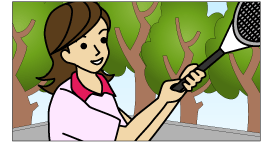Solution
You can take well balanced shots if you change the size and position of the person on the screen to match the part of the subject you want to emphasize. For example, when you want to show the subject's whole body, the image will not be very good if the head or feet are cut off. To avoid such situations, it is important that you fix the composition and pay attention to the balanced placement of the subject on the screen.
This section describes the basic shots and framings for human figures.
Depending on the angle of view and the size of the person.
Full shot
This shot fits the subject's whole body within the frame. This type of shot conveys the subject's surroundings or actions involving the whole body. Try shooting shots like this with some space above the subject's head and below the feet.
Waist shot
This shot shows the subject from the waist upward. It works well to show the subject's facial expression with some of the surroundings. Try shooting the shot with some space above the subject's head and positioning the eyes above the center line of the screen.
Bust shot
This shot shows the subject from the chest upward. It works well to show the subject's facial expression and provides a sense of closeness. It is okay to take these shots without consciously leaving space above the subject's head.
Close-up
This shot shows the subject's whole face on the screen. It is effective for emphasizing subject's expression. Try shooting the shot, positioning the subject's nose at the center line of the screen.
Extreme Close-up
This shot is used to enlarge the part of the subject that you want to emphasize, for example, the eyes, mouth, fingers, hands, or feet. It is effective at appealing directly to the people who look at the image.
Shooting well balanced compositions with thought given to what you want to convey to the people looking at the image is part of the basics photography.
Horizontal framing
The point of this shot is to open up some space in the direction the subject facing. There are the following differences, depending on the subject's placement in the image: right, left, or center.
Center: when you want to focus attention to your subject
Left/Right side: when you want to show the subject and his or her surroundings including the background.
(The image above is not balanced because there is not enough space in the direction the subject faces.)
Vertical framing
The point of this shot is to position the subject's eyes at or slightly above the center of the screen.
(In the case of the image above, people may not know which part they should be looking at if the eye position is below the center line.)
Diagonal framing
The point of this shot is to shoot diagonally to bring out a sense of depth in the image.
(In the images above, the subject blocks the trees in the background in the shot in the below, resulting in an image that lacks.)












